Do Narrow Band Filters For Telescope Add Color
A Guide to Imaging Filters
- i. Overview
- ii. Colour Filters for Astrophotography
- iii. Broadband Lite-Pollution Filters for Astrophotography
- 4. Line Filters for Astronomical Imaging
- 5. Summary
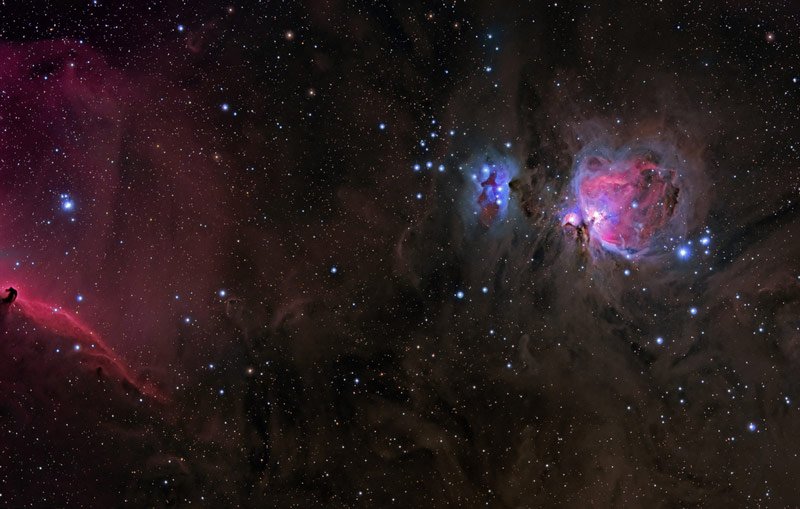
Figure 1-one: A multi-panel epitome of the Orion and Horsehead Nebulae. The images are a composite of divide images taken with an H-alpha line filter and carmine (R), light-green (B), and blue (B) color imaging filters. The H-alpha image was taken from a big urban location most Toronto, Canada. Credit: Adam Evans/Flickr.
1. Overview
Thanks to continuous advances in semiconductor technology and image processing techniques, amateur astronomers at present have at their disposal photographic camera technology that rivals what was available to professional person astronomers less than 20 years ago. Compared to the old days of film astrophotography, mod digital astronomy cameras and DSLRs are extremely sensitive and relatively piece of cake to use, and they create images that tin can be hands enhanced with sophisticated processing software.
Just applied science is never a substitute for getting a correctly exposed image onto the camera sensor. That's why astrophotographers must yet sympathise how to focus the image from a telescope, track the image during long exposures, and combine and process images to maximize detail and minimize noise. They must as well understand how to select and utilise optical filters for astrophotography. Such filters, which are placed in the optical path of a telescope in forepart of the camera, allow selected bands (or colors) of light to autumn on the sensor. Filters are used to heighten particular and contrast in many astronomical objects. They are also essential in producing the sharpest possible colour images with monochrome CCD and CMOS cameras.
Selecting filters for astrophotography is sometimes a little confusing for new imagers. This article helps you understand the basics of astronomy filters for astrophotography including color filters, broadband and narrowband filters for light-pollution reduction, and spectral line filters for maximizing item in images of emission and planetary nebulae and supernovae remnants. Once you read through this commodity, yous will accept a better understanding of which filters to choose for many types of celestial objects.
2. Color Filters for Astrophotography
All semiconductor sensors in digital cameras produce inherently monochrome images. But some astronomy cameras and all DSLR cameras are engineered to produce color images by using a matrix of red, light-green, and blueish filters, called a Bayer filter, in forepart of the sensor, along with some clever processing. Color digital cameras tin can piece of work well in astronomy imaging of planets and deep-sky objects, especially for first imagers. What such cameras offer in convenience and ease of use, notwithstanding, they tin can take away in paradigm sharpness and color allegiance in many astronomical objects.
To go the sharpest possible color images, many experienced imagers prefer using monochrome cameras without a Bayer filter in forepart of the sensor. Instead, they take several images of a celestial object, each with a divide color filter placed in front of the camera. Each epitome is combined and processed with software to produce a single true color prototype. The colour filters themselves are designed to adapt to one of two standard systems designed by professional astronomers long ago for measuring the effulgence of stars.

Figure ii-1: Red (R), green (One thousand), and blue (B) images of Jupiter, and the resulting RGB combined image. Credit: Johan Warell, Lindby Observatory.
Most amateur astronomers and imagers use the LRGB color system with monochrome astronomy cameras. A sharp and detailed monochrome image is made with the Luminance ('Fifty') filter that encompasses the full range of the visual spectrum from about 400-700nm. Then color data is added with separate exposures with a Red (R), Dark-green (G), and Blue (B) filter. The filters are typically inserted and swapped out using a manual or electronically controlled filter wheel. The resulting individual images are candy and combined into a single epitome. These filter sets can be used for planetary imaging and deep-sky imaging.
Figure ii-2 shows the bands of an LRGB filter set. This colour system includes a small gap between the green and ruddy filters to minimize the event of narrowband low-cal pollution from mercury and sodium street lamps. The filters do laissez passer light at the wavelengths of H-beta (486 nm), OIII (501nm) and H-alpha (656nm) which is commonly emitted by many nebulae and supernova remnants.
Each of the filters in an LRGB prepare block ultraviolet (UV) and infrared (IR) light considering, while the camera sensor is sensitive to this light, many telescopes fail to bring this calorie-free to a tight focus at the same plane as visible light. This can event in swollen star and less than sharp images. Some LRGB filter sets include some other clear ('C') filter to aid in focusing.
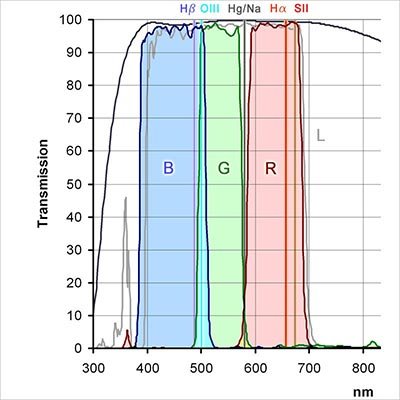
Figure two-2: The passbands of a Baader LRGB filter set up. Credit: Baader Planetarium.
On the other manus, some imagers wish to capture planetary detail Only in the infrared. In this case, an IR pass filter is placed in front of a monochrome camera instead of a color filter.
A UBVRI filter set provides an alternative to the LRGB system. This system passes light in the ultraviolet (U), blue (B), visual (V), carmine (R), and infrared (I) wavelengths. Information technology is less widely used by imagers, though information technology is an essential system for precisely measuring the colors and brightness of stars. Baader and Optolong offer UBVRI sets of filters mounted in a 1.25" and 2" cells.
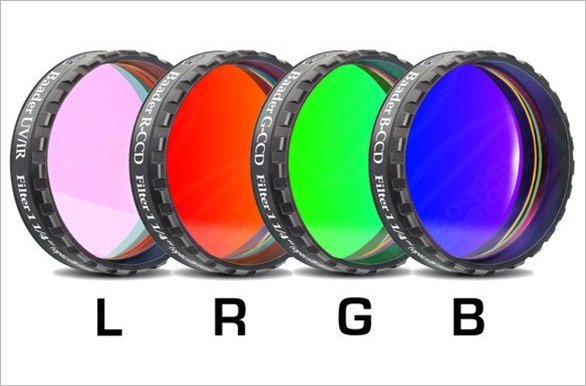
Effigy ii-3: A set of LRGB filters. Credit: Baader Planetarium.
While near color filters are mounted in 1.25" or two" threaded cells, some manufacturers, including ZWO, besides provide unmounted filters in 31mm and 36mm diameters for direct insertion into filter wheels or filter holders.
Some Recommended LRGB and UBVRI Filter Sets:
- Baader Planetarium has i.25" and 2" LRGB filter sets with and without clear focusing filters. See the Baader LRGB filter sets at this link.
- Optolong as well manufactures LRGB filter sets in 1.25" and two" cells too as 31mm and 36mm round unmounted filters. See the Optolong LRGB filters at this link.
- ZWO has both a standard LRGB filter set and a premium LRGB filter set.
- Baader too has a 1.25" UBVRI filter gear up for those who wish to explore imaging with this range of wavelengths. More recently, Optolong has also introduced these in 1.25" and 2" versions.
Filter Wheels
- Manual and electronic filter bicycle are available from ZWO and other manufacturers. Agena AstroProducts as well has economical 5-position transmission filter wheels for astrophotography.
3. Broadband Light-Pollution Filters for Astrophotography
Lite-pollution filters are a big assist for visual observers who wish to see emission and planetary nebulae and supernova remnants in urban and suburban skies. These filters improve the contrast of such celestial objects by passing only a ring of visible light, especially blue-green calorie-free emitted by hydrogen atoms and oxygen ions and red light emitted by hydrogen atoms, while blocking light emitted by sodium and mercury street lamps from 540-620nm and by natural sky glow at 589nm. While they are non a cure-all for light pollution, and they don't supersede truly nighttime skies, these filters are also an enormous aid in imaging many angelic objects with CCD and CMOS astronomy cameras and DSLRs coupled to telescopes. They can also help nightscape imagers using DSLR cameras and wide-angle camera lenses to get ameliorate images of the dark heaven where urban and suburban light pollution is a problem.
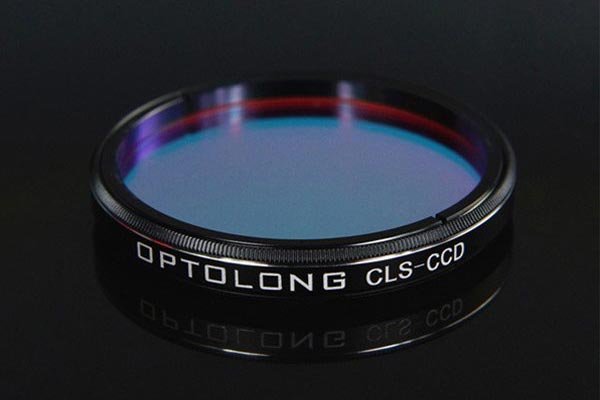
Figure 3-1: An Optolong City Light Suppression (CLS) filter. The 'CCD' designation means the filter blocks infrared lite, resulting in sharper images with CCD and CMOS cameras.
Equally mentioned in a previous Agena article on visual observing with low-cal pollution filters,these filters autumn into ii main classes: narrowband and broadband. Narrowband filters have a passband of 20-30nm wide centered around the H-beta wavelength at 486nm and OIII wavelengths at 496nm and 501nm in the blue-green part of the spectrum. Since they take a smaller passband, these filters reject more calorie-free pollution and offer higher contrast on many nebulae, especially planetary nebulae.
Broadband low-cal pollution filters have a passband of 50-60nm in the blue-green, so they turn down lite pollution, especially broadband light pollution, to a lesser degree. But many such filters as well pass red calorie-free from H-alpha at 656nm (see Figure iii-two). This light is not useful for visual observers because the eye is relatively insensitive at this wavelength. Simply CCD and CMOS astronomy cameras are very sensitive at 656nm, so these broadband filters are particularly useful for imaging nebulae, especially cerise-pink emission nebula such at the Orion and Lagoon Nebulae.
The sensitivity of camera sensors in the scarlet and infrared, as well as in the ultraviolet, has a downside however.IR or UV light is often brought to focus by refractor telescopes and camera lenses at a slightly different plane than visible light. So if IR and UV calorie-free from stars passes through a broadband or narrowband filter, then bloated and out-of-focus star images can result. That'south why most serious imagers cull filters that cake infrared and ultraviolet light, or they add a second UV/IR cut-off filter to practise the job.
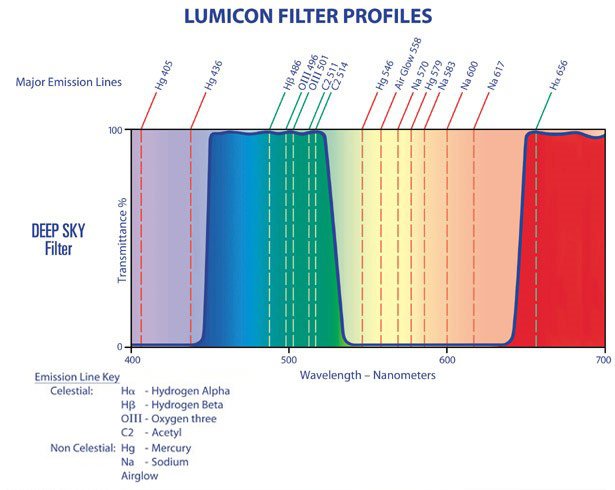
Effigy 3-2: Broadband low-cal pollution filters such as the Lumicon Deep-Heaven Filter transmit the widest passband of all light-pollution filters. These filters pass lite from H-beta, OIII, and H-alpha. Image courtesy of Lumicon.
Broadband and narrowband filters can exist used with monochrome cameras to produce detailed monochrome images to suppress light pollution and provide good paradigm contrast. Or they tin be used with color astronomy cameras, DSLRs, and astronomy video cameras such as Mallincamsor the Revolution Imager. Because they practise not pass the full band of visible lite, even so, these filters can produce distorted colors in stars and other broadband low-cal sources when used with color cameras. This is especially true of nebula filters than merely pass blue and greenish light.
Light-pollution filters tin can also be used with DSLR cameras and lenses to reduce the furnishings of light pollution when taking wide field nightscapes with a photographic camera lens. In this awarding, accurate color reproduction is of import to faithfully capture the colors of stars. So some filter manufacturers have developed broadband lite pollution filters than pass selected bands of low-cal across the visible spectrum in the blueish, green, yellow, and carmine while nonetheless excluding the light pollution bands. The 50-Pro filter from Optolong, for instance, offers better color correction than its CLS-CCD filter. This filter, also as the CLS-CCD filter, are offered in standard one.25" and 2" cells besides equally clip-in format for select Catechism and Nikon DSLR cameras. The well-regarded IDAS LPS filter also works well to balance color and reduce the effects of light pollution.

Effigy 3-iii: A comparison of the passbands of the Optolong L-Pro filter (left) and the CLS-CCD filter (correct). The passband is shown in red; nebula wavelengths are in green; lite pollution from sodium and mercury lamps is in orangish. The L-Pro filter passes light from many bands across the visible spectrum. The CLS-CCD filter just passes calorie-free in the blue-green and red function of the spectrum. This distorts the colour of stars, merely the CLS-CCD filter has superior contrast and rejection of UV and IR light.
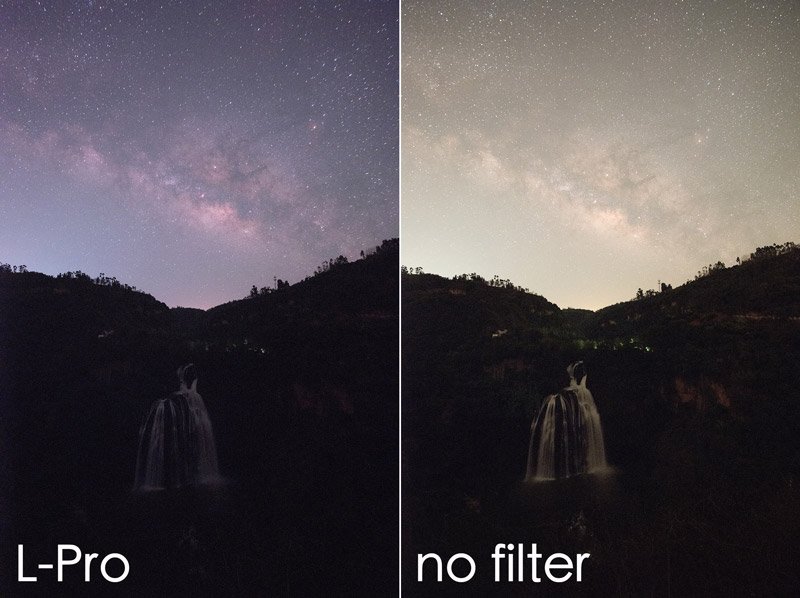
Figure 3-4: Nightscape images taken with a DSLR photographic camera with an Optolong Fifty-Pro filter (left) and with no filter (right). Image credit: Optolong.
Some Recommended Narrowband and Broadband Filters Filter Sets:
- Lumicon Deep-Sky filter and Baader UHC-S filter both pass blue-green light from OIII and H-beta and red light from H-alpha. They are designed to not block IR and UV light. The Optolong CLS filter has similar characteristics, but the Optolong CLS-CCD filter includes IR/UV cake characteristics to help imagers get sharper star images; it'south one of the few filters in this bandwidth course that does and so. Astronomik makes a similar CLS-CCD filter for the photographic applications.
- The Optolong 50-Pro filter, as mentioned in a higher place, has amend color characteristics but rejects less light pollution.
- For narrower-band applications in the bluish-green role of the spectrum, the Lumicon UHC filter and the Orion Ultrablock filter work well to reject calorie-free pollution, though neither is optimized to reject UV and IR light. The Astronomik UHC filter has a very narrow ring in blue green but also passes H-alpha in reddish which makes information technology useful for basic imaging and video astronomy.
- If required, separate UV/IR block filters tin can be threaded into broadband or narrowband calorie-free-pollution filters. These blocking (or 'cut') filters are available from several manufacturers including ZWO, Baader Planetarium, and Optolong.
4. Line Filters for Astronomical Imaging
To bring out the maximum corporeality of item and dissimilarity in many types of nebulae and supernova remnants, and in large spiral galaxies where large emission nebulae are visible, serious astrophotographers use very narrowband line filters that pass simply a single spectral line emitted by one blazon of cantlet or ion. These filters have a very narrow bandwidth of less than x-15nm, and premium line filters take bandwidths of less than 5nm. Smaller bandwidths pass less light and require longer exposures, but they offer improve contrast and paradigm item. They likewise take superb rejection of light pollution, and then these filters can be used to epitome nebulae and supernova remnants even in suburban and urban skies or in brilliant moonlight. The imager of Effigy 1-i, for case, nerveless low-cal through a narrowband H-alpha filter from the large urban center of Toronto, Canada. The filter had a narrow bandwidth to exclude most of the light pollution.
Because they pass so footling calorie-free, however, these filters are non recommended for visual observation.
The most common line filters for astrophotography include:
Hydrogen Blastoff (656nm). The most commonly used line filter, the H-alpha filter passes carmine light emitted past ionized hydrogen and brings out the fine, fragile item in emission nebula and supernova remnants. The filter is too useful for bringing out HII (ionized hydrogen) regions in nearby galaxies.
Baader H-Alpha filters
Optolong H-Alpha filters
(SAFTETY NOTE: H-blastoff filters for imaging CANNOT be used for observing or imaging the Dominicus. H-alpha solar filters also laissez passer 656nm low-cal from the Sun. For this reason, these filters are sometimes call "Dark Heaven" H-blastoff filters. H-alpha imaging filters; they have far narrower bandwidths and they also come with associated hardware that is designed to reduce the Sun's light to a safety level.)
Hydrogen Beta (486nm). Likewise used in improving contrast and detail in emission and planetary nebulae, H-beta filters tin gear up off glowing regions of gas against dark nebula. Many H-beta filters, such as those from Lumicon and Explore Scientific, are for visual observing only and do not include the necessary UV/IR blocking characteristics. Recommended H-beta filters include:
Baader H-Beta filters
Optolong H-Beta filters
Oxygen (OIII - 496nm and 501nm). OIII filters are very useful for extracting detail from planetary nebulae and some emission nebulae and supernova remnants while blocking much of the lite from stars and other broadband light sources.
Baader OIII filters
Optolong OIII filters
Sulfur (SII - 672nm). There is very little sulfur in nebulae, but the SII emission is stiff and well favored for the concrete conditions in many such objects. The deep-ruby calorie-free from SII reveals delicate particular that may be distinct from regions that emit light from hydrogen. When used with monochrome cameras, images of SII emission at 672nm is often assigned a false color.
Baader SII filters
Optolong SII filters
All of the in a higher place filters have bandwidths that range from 12nm to 6nm, and even to 3nm in the case of the high-end filter sets from AstroDon. Some line filters are likewise available in larger 25nm bandwidths. Smaller bandwidths have the reward of improving dissimilarity and particular in nebulae, even in conditions of serious light pollution or moonlight.
The elevation transmission of line filters is also an essential specification. Information technology's especially hard to engineer these filters to have both very narrow bandwidth and high transmission. Mid-range filters with bandwidths of less than 7nm have peak transmission of 85-90%. More expensive filters can have slightly higher manual which reduces exposure times.
Most line filters are mounted in 1.25" or two" threaded cells, and they are too provided in unmounted filters in 31mm and 36mm diameters for direct insertion into filter wheels or filter holders.
Similar LRGB color filters, line filters are generally used only with monochrome cameras. The imager takes a series of monochrome images, each with a split up line filter placed in front end of the camera, and each image is combined into a single color paradigm using epitome processing software. Each wavelength is assigned a truthful color or, more than commonly, a imitation color from a standard astronomical color palette. The most common palettes are the Hubble Space Telescope (HST) Palette and the Canada-French republic-Hawaii Telescope (CFHT)palette. In the HST palette, H-blastoff is assigned the colour green, OIII is assigned blue, and SII is assigned scarlet. In the CFHT palette, H-alpha is assigned cherry, OIII is assigned greenish, and SII is assigned blue.
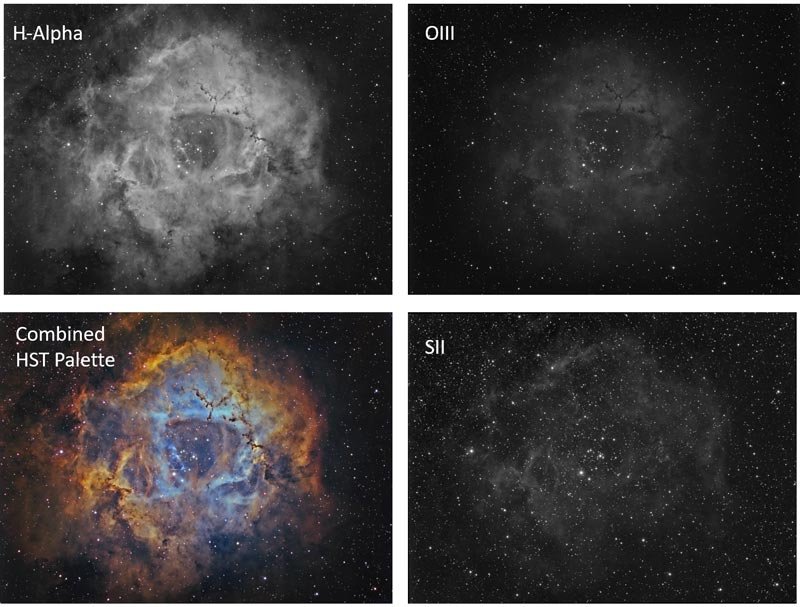
Figure 4-1: Clockwise from upper left, an prototype of the Rosette Nebula taken through narrow line filters including H-alpha, OIII, and SII. At lower left, all three images are combined using the colors of the Hubble palette. Image credit: Terry Hancock at www.GrandMesaObservatory.com
Since line filters have very narrow bandwidths, star images are frequently quite dim. To bring upwardly the stars, boosted images are taken through LRGB filters, and these images are combined with images from line filters to produce a final image. Some manufacturers such equally Optolong and ZWO include line filters with LRGB filters for a full ready of imaging filters in a number of size formats for deep-sky objects.
5. Summary
This guide explained the nuts of color, broadband, and line filters for astrophotography. Such filters, which are placed in the optical path of a telescope in front end of the camera, allow selected wavelength bands of light to fall on the sensor. Filters are used to enhance detail and contrast in many astronomical objects. They are also essential in producing the sharpest possible color images with monochrome CCD and CMOS cameras. Colour filters such as LRGB filter sets are useful for imaging planets and deep-sky objects. Broadband filters can reduce the effects of light pollution when imaging through a telescope with or with DSLR cameras and lenses. And spectral line filters are essential for maximizing item in images of emission and planetary nebulae and supernovae remnants, peculiarly when used with monochrome astronomy cameras.
Commodity and photos © Agena AstroProducts, 2017. Reproduction without permission prohibited.
Do Narrow Band Filters For Telescope Add Color,
Source: https://agenaastro.com/articles/guides/guide-to-imaging-filters.html
Posted by: howletthanceseles1941.blogspot.com


0 Response to "Do Narrow Band Filters For Telescope Add Color"
Post a Comment